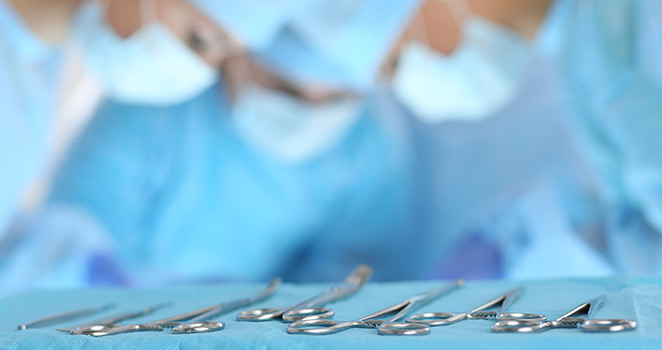Atrium Health Navicent Gastroenterology
Barrett's Esophagus with ablation

Barrett's esophagus is a complex condition that involves not only the esophagus but also the intestinal tract and stomach. While the condition does not typically cause any significant symptoms, it can develop into a serious condition if left untreated. Understanding the pathology of the condition as well as the primary way to treat it is important to prevent progression of the condition as well as any underlying concerns.
What is Barrett's Esophagus?
All too often patients are diagnosed with a condition without truly understanding how it is affecting their bodies. Gaining an understanding of how this condition develops and may progress will help you effectively weigh your options and consider effective treatment.
Barrett's esophagus is a condition in which tissue located in the esophagus, the tube connecting the mouth and stomach, is replaced by tissue similar to that of the intestinal lining. The condition is most often diagnosed in individuals who have had long-term gastroesophageal reflux disease also known as GERD. GERD is a condition typified by the regurgitation of acid from the stomach into the lower esophagus. While Barrett's esophagus is primarily found in people with reflux, still only a small percentage of people with the condition ever develop Barrett's esophagus.
Recognizing and receiving appropriate treatment for this condition of the esophagus is particularly important because it is increased with a heightened risk of developing esophageal cancer. While the risk is small, it is important to maintain regular checkups to locate any precancerous cells. If such cells are identified, they can be treated to prevent full development of cancer.
What are the Symptoms and Causes of Barrett's Esophagus?
Barrett's esophagus actually does not present any identifiable symptoms; however, most individuals with the condition do have GERD. This condition does cause symptoms, including excessive heartburn, belching, difficulty swallowing, inflammation of the gums, and more.
At this point, experts have not identified an exact cause of the condition. Some factors have been identified that may contribute to one's chance of developing the condition, though.
What Factors Contribute to the Development of Barrett's Esophagus?
As previously stated, having GERD significantly increases one's chances of developing Barrett's esophagus. This condition is a more progressive, chronic form of gastroesophageal reflux, which involves the repeated regurgitation of stomach acid into the base of the esophagus. This refluxed acid enters the esophagus and can cause heartburn and begin to damage the cells of the esophagus. Roughly 5 to 10 percent of individuals with GERD will develop Barrett's esophagus.
Additionally, obesity and having particularly high levels of belly fat specifically as well as smoking also increase an individual's chances of developing Barrett's esophagus. Studies also suggest that genetics may also play a role in whether an individual will or will not develop the progressive condition.
What Treatments are Available for Barrett's Esophagus?
It is important to discuss the different treatment options with your doctor. Depending on your overall health as well as whether or not you have dysplasia, you may be recommended for different treatment options, including medication for GERD, surveillance, surgery, mucosal resection, or ablation. While each of the treatments is effective in their own right, ablation is one of the most commonly applied therapies for the condition.
Treating Barrett's esophagus with ablation involves different techniques used to destroy the intestinal cells in the esophagus. Once the treatment has been applied, the body typically begins producing normal esophageal cells again.
What are the Options for Treating Barrett's Esophagus with Ablation?
Radiologists at specialized hospitals and outpatient facilities typically apply these therapies. Individuals who undergo the procedure are given local anesthesia and a sedative. The most common forms of ablation used to treat the condition are photodynamic therapy and radiofrequency ablation.
Photodynamic therapy involves using a light-activated chemical known as porfimer or Photofrin, an endoscope, and a lancer to target and eliminate precancerous cells in the esophagus. To complete the procedure, a doctor injects the porfimer into the patient's arm. The procedure is then completed 24 to 72 hours after the injection. While this treatment is effective, it is not without potential side effects. Complications of this type of therapy may include sensitivity to light for 6 weeks following the procedure, burns and swelling of the nearby healthy tissue, trouble swallowing, stomach pain, coughing, and even painful breathing.
Radiofrequency ablation is an alternative procedure that involves the use of radio waves to eliminate precancerous and cancerous cells found in the esophagus with Barrett's tissue. With this procedure, an electrode is mounted on a balloon or endoscope that is extended into the esophagus. The electrode creates heat that acts to destroy Barrett's tissue and precancerous and cancerous cells. Complications of this treatment include chest pain, cuts in the lining of the esophagus, and strictures. However, clinical trials have indicated that complications are less common with radiofrequency ablation compared to photodynamic therapy.
How Do Patients Prepare for Ablation Therapy?
While the assisting doctor will provide specific pre-procedure instructions, treatment most often includes an adjustment of the patient's typical medications. It is important that one's acid reflux is well-controlled before, during, and after the procedure, so the doctor may suggest an adjustment in acid suppression medication. Likewise, platelet-inhibiting, anticoagulant, and/or non-steroidal anti-inflammatory medications may be adjusted with consideration of one's bleeding characteristics.
The day before the procedure, most patients are asked to fast. This instruction typically involves refraining from eating or drinking after midnight the night before the procedure. In any case, it is important that each patient confirms specific instructions with his or her doctor prior to the procedure.
Barrett's esophagus is a condition that can cause significant concern if not treated properly. Regular monitoring, as well as effective management of GERD, are typically the primary treatments for the condition. However, if it progresses, treating Barrett's esophagus with ablation therapy is an effective solution in most cases.